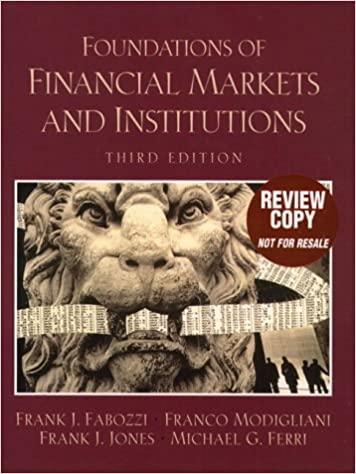Question
QUESTION 35 For the next two questions suppose the following data: Ruth Company currently has $1,000,000 in accounts receivable. Its days sales outstanding (DSO) is
QUESTION 35
For the next two questions suppose the following data:
| Ruth Company currently has $1,000,000 in accounts receivable. Its days sales outstanding (DSO) is 40 days (based on a 365-day year). Assume a 365-day year. |
How much is the Ruth's current annual sales revenue?
|
| $8,225,000 | |
|
| $8,500,000 | |
|
| $8,875,000 | |
|
| $9,000,000 | |
|
| $9,125,000 |
QUESTION 36
The company wants to reduce its DSO to the industry average of 25 days by pressuring more of its customers to pay their bills on time. The company's CFO estimates that if this policy is adopted the company's average sales will fall by 10 percent. Assuming that the company adopts this change and succeeds in reducing its DSO to 25 days and does lose 10 percent of its sales, what will be the level of A/R following the change?
|
| $500,000 | |
|
| $525,000 | |
|
| $562,500 | |
|
| $625,000 | |
|
| $675,500 |
QUESTION 44
The following information applies to the next 10 problems.
| Rollins Corporation is determining its WACC. Its target capital structure is 30 percent debt, 10 percent preferred stock, and 60 percent common equity. Its bonds have a 9 percent coupon, paid semiannually, par value of $1,000, a current maturity of 30 years, and sell for $905.35. The firm could sell, at par, $100 preferred stock which pays a 10 percent annual dividend, but flotation costs of 3 percent would be incurred. Rollins' beta is 1.5, the risk free rate is 5 percent, and the expected return on the market portfolio (= rM) is 12 percent. Rollins is a constant growth firm which just paid a dividend of $2.00, sells for $20 per share, and has a growth rate of 5 percent. The firm's net income is expected to be $2 million, and its dividend payout ratio is 30 percent. After flotation costs, new common stock will sell for $17. The firm's marginal tax rate is 40 percent. |
What is Rollins' after-tax component cost of debt?
|
| 4% | |
|
| 4.5% | |
|
| 4.8% | |
|
| 5.2% | |
|
| 6% |
QUESTION 45
What is Rollins' cost of preferred stock?
|
| 8.92% | |
|
| 9.76% | |
|
| 10.31% | |
|
| 11.12% | |
|
| 12.34% |
QUESTION 46
What is Rollins' cost of retained earnings using the CAPM approach using the unadjusted beta?
|
| 12.1% | |
|
| 12.7% | |
|
| 13.6% | |
|
| 14.1% | |
|
| 15.5% |
QUESTION 47
What is Rollins' cost of retained earnings using the CAPM approach using the adjusted beta?
|
| 12.67% | |
|
| 13.43% | |
|
| 13.82% | |
|
| 14.33% | |
|
| 15.67% |
QUESTION 48
What is the firm's cost of retained earnings using the DCF approach?
|
| 12.9% | |
|
| 13.4% | |
|
| 14.4% | |
|
| 14.7% | |
|
| 15.5% |
QUESTION 49
What is the average of the firm's cost of retained earnings based on the three methods above?
|
| 12.41% | |
|
| 13.37% | |
|
| 14.67% | |
|
| 15.11% | |
|
| 16.23% |
QUESTION 50
What is Rollins' lowest WACC? Use the average rs.
|
| 10.85% | |
|
| 11.90% | |
|
| 11.41% | |
|
| 11.68% | |
|
| 11.87% |
QUESTION 51
What is the flotation cost adjustment in the estimation of the cost of externally-generated new common stock using the DCF?
|
| 1.04% | |
|
| 1.54% | |
|
| 1.85% | |
|
| 2.24% | |
|
| 2.44% |
QUESTION 52
What is the firm's cost of externally-generated new common stock based on the average rs and the flotation cost adjustment?
|
| 14.67% | |
|
| 15.81% | |
|
| 16.27% | |
|
| 16.96% | |
|
| 17.57% |
QUESTION 53
What is Rollins' WACC once it starts using new common stock financing?
|
| 10.92% | |
|
| 11.55% | |
|
| 11.96% | |
|
| 12.44% | |
|
| 13.01% |
Step by Step Solution
There are 3 Steps involved in it
Step: 1

Get Instant Access to Expert-Tailored Solutions
See step-by-step solutions with expert insights and AI powered tools for academic success
Step: 2

Step: 3

Ace Your Homework with AI
Get the answers you need in no time with our AI-driven, step-by-step assistance
Get Started


